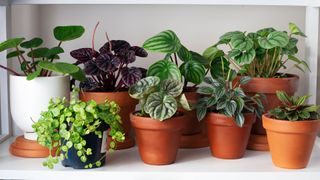Do indoor plants purify air?
By Lawrie Jones
Introducing flora to a room can improve the way it feels, but do indoor plants purify air?

House plants have become incredibly popular in recent years, but do indoor plants purify air?
So, while house plants are sometimes advertised as a way to purify the air in your home, is there actually any truth in that? Here we look into the science behind plants and their effect on air quality.
You might already know that air quality, in general, is affected by carbon dioxide, carbon monoxide, nitrous oxide, as well as volatile organic compounds (VOCs), which can exist in some of the products and materials inside our homes.
Through photosynthesis, plants convert the carbon dioxide we exhale and also remove gases from the air through a process called absorption.
In an often-cited 1989 report, NASA scientist Bill Wolverton claimed that household plants could provide a "promising economical solution to indoor air pollution." Wolverton studied the ability of plants to remove VOCs from the environment and their potential for use in deep-space missions. However, more recent research has poured cold water on the idea.
DO INDOOR PLANTS PURIFY AIR?
Scientists studying the effectiveness of indoor plants for the passive removal of ozone, found houseplants make "at best, modest contributions of about 0.9–9% to indoor ozone removal effectiveness," they reported in 2017 in the journal Building and Environment. The tests, performed in a laboratory to simulate the effects on a typical U.S. home, found houseplants barely affected the environment. To make a meaningful difference to the air quality of your home, you'd need to fill a room from top to bottom with plants, they suggest.
While a single spider plant won't purify the air, a green wall covered in plants just might found scientists in a study published in 2020 in the Journal of Environmental Management. The scientists concluded that a green wall filled with suitable plant species "can be used to create a horticulturally sustainable internal green wall, and improve the health index in the building interior environments."
So, in high enough quantities, plants can improve air quality. But what should we buy? Sadly, science doesn't have the answer (yet).
A 2018 paper published in Trends in Plant Science is confident that plants remove pollutants, but there is little research into which species are most effective. The paper concludes that "the capacity of plants to remove indoor air pollutants through stomatal uptake (absorption) and non-stomatal deposition (adsorption) remains largely unknown."

DO INDOOR PLANTS HAVE OTHER HEALTH EFFECTS?
During COVID-19 lockdowns, many of us decided to get our hands dirty and get into gardening – but was there any health benefit to this?
In a study published in May 2021 in the journal Environmental Research, scientists studied 323 students and found that houseplants were linked to feelings of "being away while at home" providing a staycation for the mind that improves mental health.
While it's unclear whether plants purify the air, a recent study from Princeton University finds that gardening is beneficial for physical and mental health. While another study cited in the Journal Physiological Anthropology involving young adult males found that indoor gardening lowered stress responses compared to the demands of completing a computer task. When sitting in front of a computer and asked to complete a task, researchers identified an increase in blood pressure, heart rate, and stress that wasn't present when the same group was gardening.
ARE INDOOR PLANTS SAFE FOR PETS?
Introducing more plants and greenery to the home can have benefits, but are indoor plants safe for pets?
Most people know that lilies are dangerous to cats and tomato plants to dogs, but many other species also threaten the health and wellbeing of our pets. There are too many to list here but there's a full list of poisonous plants available on the ASPCA's website.
What happens if your pet does eat your plants? Alexander Campbell of the Veterinary Poisons Information Service (VPIS) said: "In many cases, animals remain asymptomatic or suffer little more than gastrointestinal upset. There are a few instances where more severe clinical effects have resulted."
One of the biggest challenges for vets is knowing what a pet has ingested, researchers caution. The simple solution? Remove any known contaminants from your home or garden.
So, we've covered how plants affect the air in our homes and whether they're harmful to our pets. And while plants can make your home a more pleasant environment and taking care of them can have mental health benefits, it's unlikely they'll do much to purify the air - unless you're going to buy hundreds. So if you're concerned about air quality in your home, we advise you to invest in an air purifier, preferably one fitted with a high-quality HEPA filter.
Editor's note: This article was updated to indicate that plants are "flora" not "fauna," as had been stated earlier.

Lawrie is a journalist and editor who writes about healthcare, science, technology, engineering and design. He's worked for some of the UK and Europe's leading titles, making complex science as simple as possible. He also owns content agency 42group where he helps household brands, academic institutions and charities to grow through engaging, informative and inspirational words.
Read more at https://www.livescience.com/do-indoor-plants-purify-air





